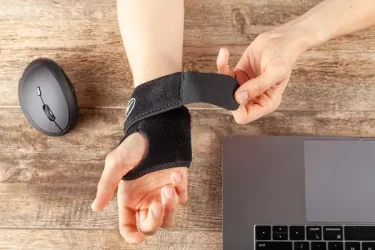Carpal Tunnel Syndrome (CTS) is a condition that can cause discomfort, pain, and weakness in your hand and wrist. Dealing with any sort of persistent pain can have a negative impact on your wellbeing – both physical and mental – so it’s important to seek help.
Understanding how to manage and relieve carpal tunnel pain is vital for improving your daily life. It can also help to prevent further complications. In this blog, we’ll explore effective strategies and tips to alleviate carpal tunnel pain and help get you back to your everyday activities.

Is carpal tunnel painful?
Carpal tunnel syndrome is a condition that affects the hand and wrist, causing pain, numbness, tingling, and weakness.
The pain is caused by compression or pressure on the median nerve. This runs through the carpal tunnel in the wrist. The symptoms can be caused by various factors including:
- hand and wrist positions
- certain medical conditions
- inflammation
- injury.
What does carpal tunnel pain feel like?
The pain can range from mild discomfort to sharp, intense pain that can be disruptive to daily activities. People with carpal tunnel syndrome often experience worsening symptoms at night.
Where does carpal tunnel pain occur?
The pain associated with carpal tunnel syndrome typically manifests in the fingers, hand, and wrist. This pain can sometimes radiate up to the forearm.
How do I know if my pain is carpal tunnel?
The following are some tell-tale signs and symptoms of carpal tunnel to watch out for:
- carpal tunnel pain typically affects the palms, index fingers, middle fingers, and part of the ring fingers. It may also cause aching or burning sensations in the wrist and hand
- persistent numbness and tingling in the fingers and thumb, especially at night or upon waking. The sensation is often described as pins and needles or an electric shock-like feeling
- carpal tunnel syndrome can lead to a weakened grip and a tendency to drop things. This is due to muscle weakness and numbness in the hand
- the pain and numbness may radiate from the wrist up to the forearm or even to the shoulder over time
- worsening symptoms at night or upon waking, potentially disrupting sleep and causing discomfort
- carpal tunnel pain may intensify during or after activities that involve repetitive hand and wrist motions. These include typing, using a mouse, or gripping objects for an extended period
- chronic symptoms that last for weeks or months, particularly if left untreated.
If you are experiencing pain similar to the points described above, it’s important to seek a professional medical diagnosis as soon as possible.
Treatment for carpal tunnel pain
There are several different methods that can offer relief from the symptoms of carpal tunnel syndrome. Most people will be advised to try non-surgical treatments first. These may include wearing wrist splints or doing hand exercises.
Take pain relief medicines
Non-prescription pain relievers and anti-inflammatory drugs (NSAIDS), such as Ibuprofen, can be helpful in managing mild carpal tunnel pain. It’s important to consult a healthcare professional before taking any medication to ensure it’s safe and appropriate for you.
Wear a wrist splint
Wearing a wrist splint at night or during activities that aggravate symptoms can provide support and help maintain a neutral position for your wrist. A splint can also reduce pressure on the median nerve and alleviate discomfort.
Take regular breaks
If you have a job that involves repetitive hand movements, take frequent breaks to rest your hands and change positions. Avoid prolonged periods of typing or using tools that may exacerbate carpal tunnel pain. Shake out your hands and stretch your fingers during breaks to relieve tension.
Massage
Regular massages of the hand, wrist, and forearm can aid in relieving tension. They can also help to reduce pain. Gently knead and massage the affected area to improve blood circulation and reduce muscle tightness. For the best results, visit a professional.
Make ergonomic adjustments
Ergonomic adjustments to your workspace can help reduce the strain on your hands and wrists. Ensuring your desk, chair, and keyboard are positioned at appropriate heights and angles will help keep your wrists and hands straight and in a comfortable position. Ergonomic keyboards and mouse pads can provide wrist support that minimises stress on the carpal tunnel.
Try carpal tunnel exercises
Regular exercises and stretches can help reduce carpal tunnel pain by enhancing flexibility and reducing stiffness in the wrist and hand. Simple exercises like wrist extensions and stretches can be beneficial. Gently bend the wrist up, down, and from side to side. Hold each position for a few seconds. Repeat these exercises several times throughout the day.
It’s important to consult a medical professional or physiotherapist to find the right exercises for you that won’t make symptoms worse.
Physiotherapy
A physiotherapist can design a personalised exercise program to strengthen the muscles around the wrist and alleviate carpal tunnel pain. They can also provide valuable advice on posture and ergonomic adjustments.
Heat therapy
Applying cold or warm compresses to the affected wrist can help to reduce inflammation. It can also temporarily alleviate pain. Cold compresses can reduce swelling, while warm compresses can relax muscles and promote blood circulation. You should alternate between cold and warm treatments to find what works best for you.
Alternative therapies
Acupuncture, chiropractic care, and yoga may offer relief from carpal tunnel pain.A healthcare professional can help determine if these alternative therapies are suitable for you.
Injections
In the event wrist splints don’t work for you, your doctor may suggest corticosteroid injections. Steroids are natural hormones produced in the body that can help reduce inflammation. For CTS they are usually injected straight into the wrist close to the nerve to try to thin thickened tissue. This is usually performed in the GP surgery or in a primary care musculoskeletal service if there is one in your area.
Carpal tunnel release surgery
If your CTS has not responded to any of the above treatments, the next step may be surgery. You should discuss this with your GP and your surgeon to make sure that all other forms of treatment have been exhausted and that you are made fully aware of the implications of surgery.
Carpal tunnel release surgery (or carpal tunnel decompression) is carried out as day surgery and takes around 15 minutes. The surgery has a high success rate and, in most cases, provides a complete cure.
The carpal tunnel surgery itself isn’t painful as you’ll have received local anaesthetic. Post-surgery discomfort can be treated with Ibuprofen or regular over-the-counter painkillers.
If your symptoms persist or worsen, it’s essential to consult a healthcare provider for a thorough evaluation and appropriate treatment. Taking proactive steps to manage carpal tunnel pain can significantly enhance your quality of life and restore comfort and functionality to your hands and wrists for the long term.
Carpal tunnel pain relief FAQs
If you haven’t yet found the information you’re looking for, our carpal tunnel syndrome pain FAQs might be able to help.
CTS can cause varying levels of discomfort throughout the day. However, the intensity and persistence of the pain can vary from person-to-person. Many people with carpal tunnel syndrome experience increased pain, numbness, and tingling during the early morning and at night.
CTS can cause pain and discomfort that radiates beyond the wrist and affects the entire arm. The symptoms often start in the hand and wrist, where the carpal tunnel is located. They can then extend up along the path of the median nerve, which runs from the forearm into the hand.
CTS often hurts more at night due to:
- wrist positions during sleep
- fluid retention
- reduced blood flow
- inflammation
- temperature changes
- heightened pain perception.
Prolonged bending of the wrist during sleep and fluid accumulation can increase pressure on the median nerve, intensifying pain and discomfort.
Try making adjustments to your sleeping position and practising good sleep hygiene. Wearing a wrist splint at night will keep the wrist in a neutral position. You could also do some gentle hand and wrist stretches before bedtime. These may help to alleviate night-time discomfort.






